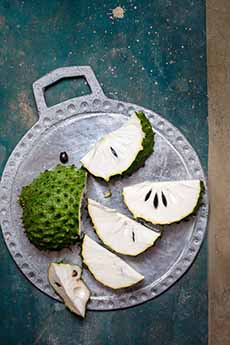What Is Soursop & How To Cook With It
|
Soursop is in season. It’s harvested in April and May, and again in September through November. What is soursop, you ask? Also known as graviola and guanabana, soursop is a heart-shaped tropical fruit (photo #2) native to the Caribbean and South America. Other names include thorny custard apple, thorny mango and thorny fruit, due to its exterior spikes (which are lightly prickly, and break off easily when ripe). The fruit now also grows in tropical regions across Africa and Asia. Is it sour? Nope! Soursop is a deliciously sweet-tart fruit with a bright flavor. The name was bestowed due to its slightly acidic taste: a pleasant tartness, like pineapple. The flavor evokes coconut and banana, with notes of citrus, pineapple, apple or strawberry, depending on where it is grown. The thick creamy, texture reminiscent of banana. Ready to blend it into a smoothie? Soursop is the fruit of Annona muricata tree, a broadleaf, flowering, evergreen tree (photo #2). It is native to the tropical regions of the Americas and the Caribbean. Soursop is in the Annonaceae family (also known as the custard apple tree family); and in the same genus, Annona,, as the cherimoya (photo #5—more about the family relationship below). The size ranges from 4 to 12 inches long and up to 6 inches wide. A single fruit can weigh up to 10 or 15 pounds, so it is often cut up and sold in pieces (photo #1). Soursop should be ripened at room temperature. As it ripens, the fruit will lighten in color to a bright yellow-green color and the spines will soften. It will have a hollow sound when tapped. A ripe soursop should yield to the touch and be somewhat fragrant of pineapple. Like most fruits, soursop is often eaten raw. You can scoop the pulpy white flesh right out of the halved fruit, with a spoon. You can find the whole fruit in specialty produce, Caribbean and Latino markets. The pulp is also sold with the seeds removed, for easy consumption. Important note: Don’t eat the seeds†. Otherwise, use the pulp to make: Soursop is low in calories and high in fiber, with zero sodium or fat. It includes a wide range of antioxidant phytochemicals*. In terms of vitamins and minerals, soursop is packed with B-complex and vitamin C, and a hit of calcium, copper, iron, magnesium, phosphorus, potassium and zinc. Soursop tea is used by some for medicinal purposes, for its perceived help in reducing the risk of certain types of cancers. It may also help to alleviate pain and decrease inflammation. However, it’s important to note that research on these applications is limited. *Phytochemicals are chemical compounds that occur naturally in plants; beta carotene from carrots is an example, as is lycopene from watermelon and tomatoes. Diindolylmethane, found in vegetables from the Brassica genus (bok choy, broccoli, Brussels sprouts, cauliflower, cabbage, kale, kohlrabi, mustard greens and turnips, among others) is being tested against respiratory tumors, cervical dysplasia and prostate cancer. Cooking may destroy the phytochemicals, which is why a raw diet is popular among a growing group of health-focused consumers. †The seeds contain some toxic compounds. |
|
|
|
|
||







